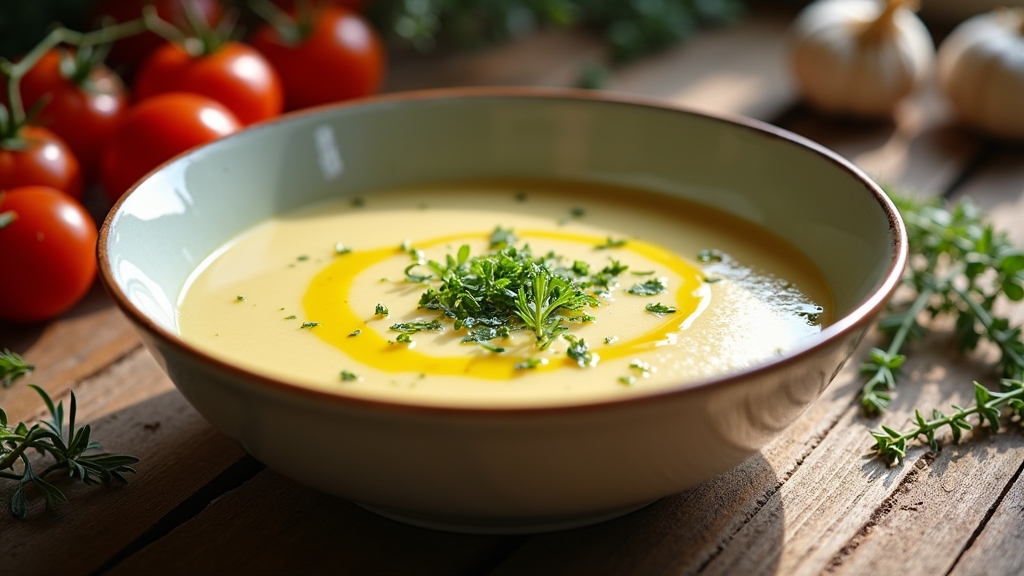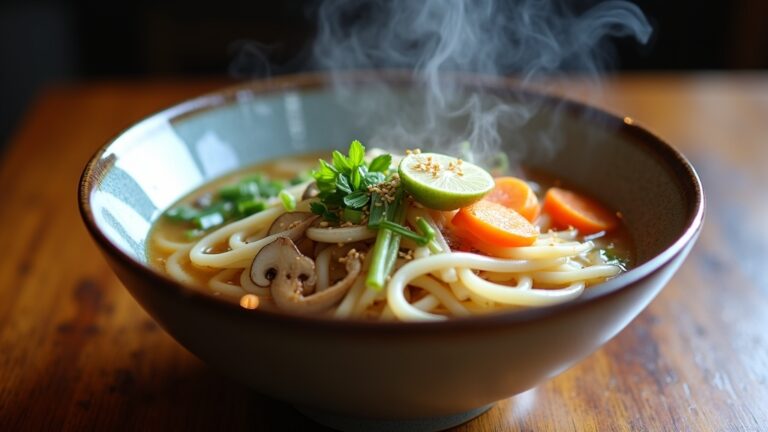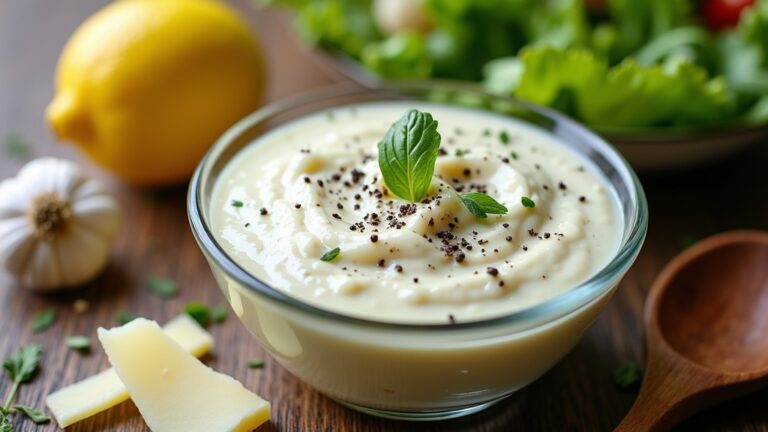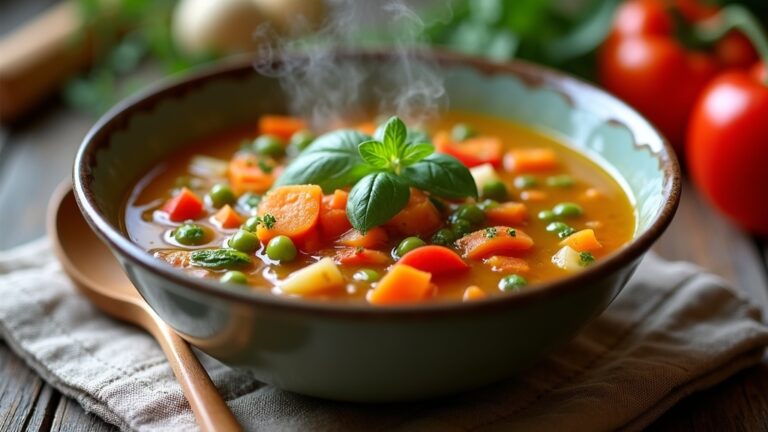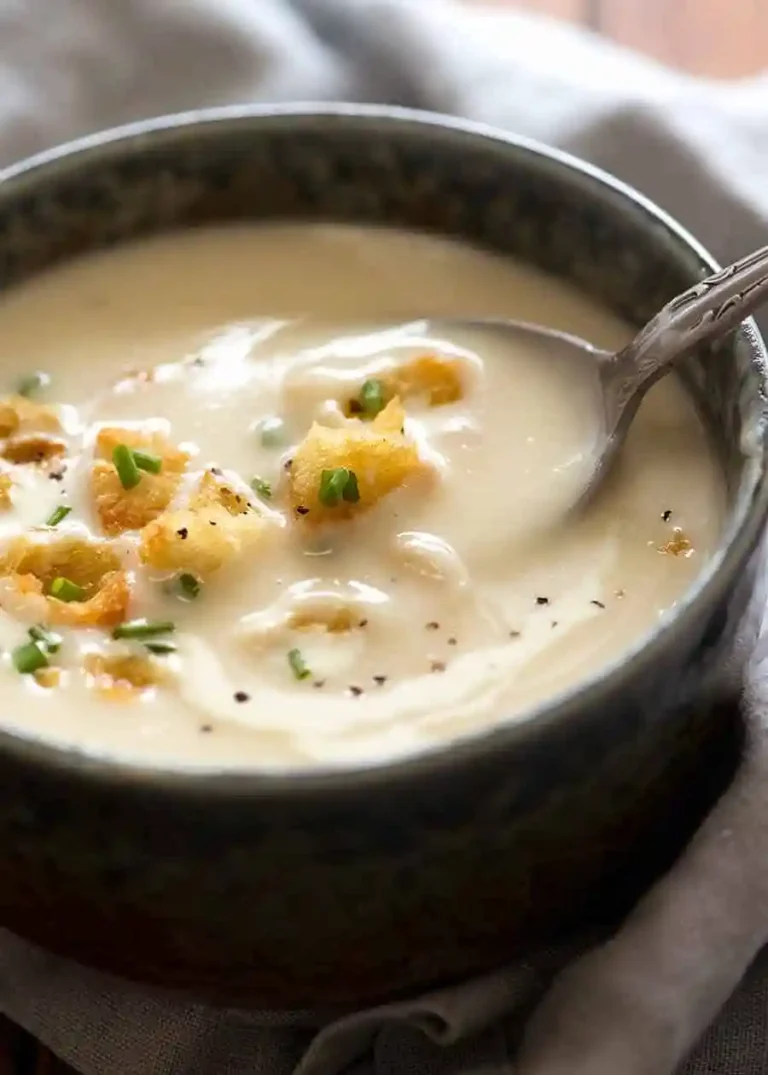Cream Soup Recipe
Cream soup is one of my favorite comfort foods, with its rich, creamy texture and endless flavor possibilities. To make it, I sauté onions until they’re soft, add in my choice of vegetables, and cover them with broth. After simmering, I blend it to a smooth consistency and finish with cream and seasoning. Garnishing with fresh herbs adds a lovely touch. If you’re curious about variations or tips to get creative with flavors, there’s so much more to explore!
Contents
History
When I think about the history of cream soups, I’m reminded of how culinary traditions evolve over time, blending flavors and techniques from various cultures. The culinary origins of cream soups can be traced back to ancient civilizations, where pureed ingredients were combined with fats and creams for richness. As I explore cultural variations, I discover how French cuisine popularized these soups, elevating them to an art form. Italian chefs added herbs and spices, while Asian cultures introduced unique ingredients like coconut milk. Each iteration reflects a community’s palate and available resources, transforming simple ingredients into comforting dishes. Today, innovation continues, as chefs experiment with unexpected flavors and textures, pushing the boundaries of this beloved classic.
Recipe
Cream soups are a comforting and versatile dish that can be enjoyed year-round. They serve as a perfect starter or a light meal, and the beauty of cream soup lies in its adaptability. You can create a variety of flavors by using different vegetables, herbs, or proteins. The creamy texture combined with the rich flavors makes it a favorite among many. Whether you prefer a classic cream of mushroom or a vibrant cream of tomato, this recipe will guide you in making a luscious cream soup that is sure to please.
To get started, gather your ingredients and prepare your workspace. The key to a delicious cream soup is to sauté the vegetables properly and allow the flavors to meld beautifully. Feel free to experiment with the base ingredients and adjust the seasoning to your liking. Once you have mastered the basic technique, you can reveal endless variations. Let’s explore the ingredients you will need and the cooking process.
Gather your ingredients and embrace the art of sautéing for a deliciously adaptable cream soup experience.
Ingredients:
- 2 tablespoons butter
- 1 onion, chopped
- 2 cloves garlic, minced
- 4 cups of your choice of vegetables (e.g., broccoli, carrots, mushrooms)
- 4 cups vegetable or chicken broth
- 1 cup heavy cream
- Salt and pepper to taste
- Fresh herbs for garnish (e.g., parsley or thyme)
To prepare your cream soup, start by melting the butter in a large pot over medium heat. Add the chopped onion and minced garlic, sautéing until they become translucent and fragrant. Incorporate your chosen vegetables and cook for an additional 5-7 minutes. Pour in the broth and bring the mixture to a boil. Reduce the heat and let it simmer for about 15-20 minutes or until the vegetables are tender. Once cooked, use an immersion blender to puree the soup until smooth. Stir in the heavy cream, and season with salt and pepper to taste. Allow the soup to heat through before serving, and garnish with fresh herbs.
When making cream soup, remember that the choice of vegetables greatly influences the flavor profile. Always taste and adjust the seasoning as needed, especially after adding the cream, as it can mellow the flavors. For additional richness, consider adding a splash of white wine before incorporating the broth. If you want to make a lighter version, you can substitute half-and-half or milk for the heavy cream. Finally, if the soup is too thick, simply add more broth or water to reach your desired consistency. Enjoy your homemade cream soup!
Cooking Steps
Now that we’ve gathered our ingredients, let’s jump into the cooking steps that turn those fresh flavors into a delightful cream soup. I start by sautéing the onions until they’re perfectly translucent, which really brings out their sweetness. From there, we’ll add the broth and let it simmer, creating a warm, inviting base for our soup.
Step 1. Sauté Onions Until Translucent
Sautéing onions until they’re translucent is an essential step that adds depth to your cream soup. This technique enhances the onion flavors, creating a rich foundation for your dish. Here’s how I do it:
- Choose your onions: I prefer yellow or sweet onions for a balanced sweetness.
- Heat the pan: I use medium heat and add a splash of olive oil or butter to get started.
- Cook gently: I stir occasionally, ensuring the onions soften without browning. This takes about 5-7 minutes.
- Add seasoning: Once translucent, I sprinkle in a pinch of salt, helping to draw out moisture and enhance those delicious onion flavors.
Step 2. Add Broth and Simmer
With the onions perfectly sautéed, it’s time to elevate the flavors even further by adding the broth. I love experimenting with different broth types—chicken, vegetable, or even a rich bone broth can dramatically change the soup’s character. Pour in the broth, ensuring it covers the sautéed vegetables, and bring the mixture to a gentle boil. Once bubbling, reduce the heat to a simmer; this is where the magic happens. Allow it to simmer for about 20 to 30 minutes, letting the flavors meld beautifully. You’ll want to keep an eye on it, stirring occasionally. This simmer duration not only enriches the taste but also enhances the dish’s overall texture, setting the stage for the next exciting step.
Step 3. Blend Until Smooth
It’s time to transform that simmered mixture into a velvety cream soup. I reach for my trusty blender, ready to use some innovative blending techniques that will elevate the texture of my dish. Here’s my approach:
- Choose Your Blender: A high-speed blender works wonders for a silky finish.
- Blend in Batches: If the pot’s too full, divide it; this guarantees even blending and prevents splatters.
- Pulse for Control: Start with short pulses, then gradually increase speed to create that perfect smoothness.
- Check Consistency: After blending, observe the texture. If you desire more variation, blend less for a chunkier feel.
With these steps, I promise a creamy, luxurious soup that’s bound to impress!
Step 4. Add Cream and Seasoning
Once the soup is beautifully smooth, I turn my attention to adding cream and seasoning, which will elevate the flavors to a whole new level. I usually reach for heavy cream for its rich texture, but half-and-half or even coconut cream can add a delightful twist depending on the desired outcome. As I pour in the cream, I watch as the soup transforms, becoming luscious and inviting. Next, I play with seasoning variations—perhaps a hint of nutmeg for warmth or a sprinkle of smoked paprika for depth. I always taste and adjust, ensuring the balance of flavors is just right. This step is all about personalizing the soup to reflect my unique culinary style.
Step 5. Garnish With Fresh Herbs
Adding a sprinkle of fresh herbs can make a world of difference in your cream soup. Not only does it elevate the dish visually, but it also enhances the flavor profile in remarkable ways. When considering your herb selection, keep these tips in mind:
- Choose herbs that complement: Basil pairs beautifully with tomato-based soups, while thyme harmonizes with creamy mushroom.
- Use fresh over dried: Fresh herbs pack a punch; their vibrant oils and aromas can transform your dish.
- Chop finely: A fine chop releases essential oils, ensuring maximum flavor enhancement.
- Garnish just before serving: This keeps the herbs bright and fresh, adding a lively touch to your soup.
Experiment with different combinations to discover your perfect blend!
Nutritional Guide
While you’re preparing to enjoy a warm bowl of cream soup, it’s important to reflect on its nutritional aspects. Cream soups can offer delightful nutritional benefits, especially when balanced with fresh vegetables and lean proteins. Portion control is key; savoring a smaller bowl can enhance your experience while keeping calories in check. Here’s a simple breakdown of what you might find in a typical serving:
| Nutrient | Amount per Serving |
|---|---|
| Calories | 250 |
| Protein | 8g |
| Fiber | 3g |
Final Thoughts
As I reflect on the comforting allure of cream soup, I can’t help but appreciate how this dish embodies both warmth and nourishment. It’s a canvas for creativity, allowing us to explore various soup variations that cater to our tastes and preferences. Whether you’re looking to indulge or eat healthily, there’s a cream soup for everyone.
Cream soup is a comforting canvas, offering warmth and nourishment while inviting endless culinary creativity.
Here are some innovative serving suggestions to elevate your experience:
- Top with fresh herbs or microgreens for a burst of flavor.
- Add a swirl of flavored oil, like truffle or chili, for sophistication.
- Pair with artisan bread or gourmet crackers for texture.
- Serve in unique bowls to create an inviting presentation.
Embrace the versatility of cream soup, and let your culinary imagination run wild!
Frequently Asked Questions
Can I Make Cream Soup Without Dairy?
Absolutely, I’ve made delicious cream soups without dairy! I love using dairy alternatives like cashew cream or coconut milk. Plant-based options bring rich flavors and creamy textures, transforming simple ingredients into something truly indulgent and innovative.
How Long Does Cream Soup Last in the Fridge?
When it comes to soup freshness, I’ve learned to follow storage guidelines closely. Typically, cream soup lasts about three to four days in the fridge. Trust me, you’ll want to savor every spoonful!
Can I Freeze Cream Soup for Later Use?
Absolutely, I freeze cream soup for later use! I use airtight storage containers and proper freezing methods to keep it fresh. Just remember to leave some space for expansion. It’s a convenient way to enjoy it later!
What Are Common Variations of Cream Soup?
I love experimenting with cream soup variations! Mushroom variations add earthy depth, while seafood options bring a delightful brininess. Combining flavors can elevate your dish, creating a comforting bowl that surprises and satisfies every time.
How Can I Thicken My Cream Soup?
Last week, I used cornstarch as a thickening agent in my soup, and it worked wonders. For alternative methods, try pureeing vegetables or adding a roux; both create a delightful, creamy texture that elevates flavors!
Conclusion
As I savored the last spoonful of my creamy soup, I couldn’t help but think how this simple recipe has connected generations of families. Who knew that with just a handful of ingredients, I could create something so comforting? It’s funny how a bowl of soup can spark memories or even bring friends together on a chilly evening. So, next time you’re craving warmth, remember this recipe—it might just turn into your own favorite tradition.
